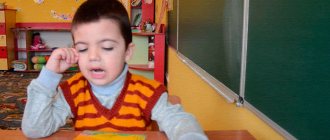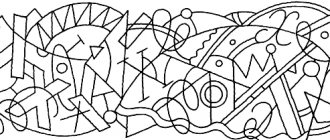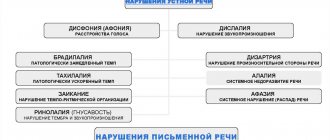Psychological and pedagogical characteristics of children with speech disorders.
Psychological and pedagogical characteristics
children with speech disorders.
Children with speech impairments are characterized by underdevelopment of all cognitive activities (perception, memory, thinking, speech). Particular difficulties of these processes are at the level of volition and awareness. Intellectual retardation in children is of a secondary nature, since it is formed as a result of underdevelopment of speech and all its components.
The attention of children with speech disorders is characterized by instability, difficulties in inclusion, switching, and distribution. In this category of children, there is a narrowing of the attention span, rapid forgetting of material, especially verbal (speech), and a decrease in active focus in the process of remembering the sequence of events and the plot line of the text.
Many of them are characterized by underdevelopment of mental operations, a decrease in the ability to abstract and generalize. It is easier for children with speech pathology to complete tasks that are presented visually rather than verbally. They need more time to understand the instructions for the task and to form ideas and concepts about the environment. Several repetitions, clarifications, and leading questions are required.
The majority of children who stutter do not have any impairments associated with intellectual retardation.
Children with speech disorders get tired quickly and have reduced performance. These children react more slowly, cannot concentrate quickly, and may have difficulty organizing themselves and managing their space. They do not get involved in completing the task for a long time. These children experience difficulties in learning to read, as well as in processing, retaining and using information obtained from reading. Some people find it difficult to grasp rhyme and have difficulty memorizing poetry.
Deviations are also noted in the emotional-volitional sphere. They are characterized by instability of interests, decreased observation, decreased motivation, isolation, negativism, self-doubt, increased irritability, aggressiveness, resentment, difficulties in communicating with others, in establishing contacts with their peers, subjective dissatisfaction, violations of self-esteem, inadaptability to frustration, decreased resistance to stress and, as a result, insufficient social adaptation.
Special educational needs.
Special educational needs specific to students with special needs include:
• identifying children at risk as early as possible during their education (together with medical specialists) and prescribing speech therapy assistance at the stage of detecting the first signs of deviations in speech development;
• organization of mandatory speech therapy correction in accordance with the identified violation before starting school; continuity of the content and methods of preschool and school education and upbringing, aimed at normalizing or completely overcoming deviations in speech and personal development;
• obtaining primary general education in educational organizations of a general or special type, adequate to the educational needs of the student and the severity of his speech underdevelopment;
• the mandatory continuity of the correctional and developmental process, implemented both through the content of educational areas and in the process of individual work;
• creation of conditions that normalize (compensate) the state of higher mental functions, analytical, analytical-synthetic and regulatory activities based on providing an integrated approach to the study of children with speech disorders and correction of these disorders; coordination of pedagogical, psychological and medical means of influence in the process of comprehensive medical, psychological and pedagogical support;
• receiving a range of medical services that help eliminate or minimize the primary defect, normalize the motor sphere, the state of higher nervous activity, and somatic health;
• the possibility of adapting the educational program when studying the content of academic subjects in all subject areas, taking into account the need to correct speech disorders and optimize students’ communication skills;
• individual pace of learning and advancement in the educational space for different categories of students with special needs;
• constant (step-by-step) monitoring of the effectiveness of the academic component of education and increasing the life competence of students, the level and dynamics of development of speech processes, based on the mechanism of speech defect;
• the use of special methods, techniques and teaching aids, including specialized computer technologies, teaching aids, visual aids that ensure the implementation of corrective effects on speech processes, increasing control over oral and written speech;
• the opportunity to study at home if there are medical indications;
• prevention and correction of sociocultural and school maladaptation by maximizing the expansion of educational space and increasing social contacts;
• learning the ability to select and apply adequate communication strategies and tactics;
• psychological and pedagogical support for the family with the aim of its active inclusion in correctional and developmental work with the child; organizing partnerships with parents.
1.1. Understanding speech, its meaning and functions in scientific literature
Speech is the highest mental function, which is the main means of expressing thoughts. Within the framework of the created A.R. Luria neuropsychology considers speech function both from the point of view of its psychological characteristics and brain organization. The complexity of the structure of speech is emphasized, in which two main levels are distinguished: 1) gnostic and praxic; 2) semantic [25, p. 79].
Gnostic and praxic functions in the structure of the speech function of A.R. Luria regarded them as basic, over which the semantic level of speech activity is systematically built up throughout life, associated with the use of language means - words, phrases constructed according to the rules of grammar.
The important role of A.R. Luria gave an indirect character to the speech function. He pointed out that speech activity requires various non-verbal supports, such as optical images and symbols of objects, ideas about quantity, time, space, etc., and at the same time it itself serves as an intermediary. Without speech it is impossible to master any field of knowledge, even mathematics, physics, chemistry, etc. This means that:
1) the acquisition of speech requires enormous and at the same time multimodal brain costs: it cannot be mastered without the formation of multiple associative connections between the most different areas of the brain;
2) mastery of any higher mental activity is impossible without activation of the pathways leading to the speech zones of the brain, and if possible, then in a significantly limited volume or in a roundabout way, such as in case of deafness, often referred to in everyday life as deaf-mutes [25, p. . 94-96].
Speech is a form of human communication through language. Speech includes the processes of generating and perceiving messages for the purposes of communication or for the purposes of regulation and control of one’s own activities. The structure of speech activity includes the phases of orientation, planning (in the form of “internal programming”), implementation and control. Depending on the type of speech activity, speech is distinguished into internal and external (oral and written) [26, p. 99].
Inner speech is various types of use of linguistic meanings outside the process of real communication. N.I. Zhinkin and A.N. Sokolov distinguishes three main types of inner speech:
1) internal pronunciation - “speech to oneself”, preserving the structure of external speech, but devoid of phonation, i.e., pronouncing sounds, and is typical for solving mental problems in difficult conditions;
2) internal speech itself, when it acts as a means of thinking, uses specific units (code of images and schemes, subject code, subject meaning) and has a specific structure, different from the structure of external speech;
3) internal programming, i.e. the formation and consolidation in specific units of the idea (type, program) of a speech utterance, the whole text and its content parts (etc.) [13, p. 106].
In ontogenesis, internal speech is formed in the process of internalization of external speech [31, p. 73]. L.S. Vygotsky considered inner speech as a compressed program of a coherent utterance [7, p. 213-217]. The expansion of the internal semantic scheme into an external statement is ensured by predicativity, which is expressed in words denoting actions, the rhythmic-intonation structure of speech and other non-formalizable components of verbal behavior. The mechanism for generating a statement, according to L.S. Tsvetkova, consists of four links: the first link begins with the formation of a motive, which in the second link is objectified in the design; in the third link, the plan is realized at the level of internal speech in the form of an internal psychological program of utterance, for which the main thing is semantics and predicativity; in the fourth link, this program is implemented in external speech on the basis of the laws of grammar and syntax of a given language [40, p. 88].
I.N. Gorelov [11] distinguishes the following stages in the process of generating a statement:
1. Motive (setting for communication).
2. Stage of communicative intention.
3. The moment of formation of the semantic content of the future utterance in the Code of Criminal Procedure (according to Zhinkin), i.e., the stage of the general plan in which a holistic semantic “picture” of the future utterance is formed: in the presence of meaning and semantics, there are no specific words and syntactic structures [14, p. 21].
4. Code.
5. Expanding the nuclear meaning (theme).
6. Syntactic scheme.
7. Grammatical structuring and morphemic selection of specific vocabulary.
After seven stages of speech production, the nasyllabic motor program of external speech is implemented. All stages of speech production are implemented quickly, in addition, the stage of speech production control is carried out in parallel. In addition to external and internal, there are impressive (perception and understanding) and expressive (reproduction) speech. The speech function occupies a key position in the development of the psyche. It is the main way of communication between people and the main tool for understanding the world. Speech activity would be impossible without mastery of the means of language, which are organized into special systems (codes). Each speaker can draw from these systems the words and rules he needs to construct an utterance.
The phonemic system of a language (phonemic code) is a set of basic means of conveying thoughts in words. The central unit of this code is the phoneme.
Communicative speech is divided into dialogical (situational and non-situational) and monological. Dialogue speech, especially situational speech, is assessed as simpler, since paralinguistic means of expressing thoughts (gestures, facial expressions, intonation) occupy a much greater place in it than in monologue. Typically, speech automatisms include ordinal and affectively colored speech (exclams, swearing, etc.) [26, p. 101-102].
Currently, thanks to the successes of neuropsychology, it has been established that speech has a dynamic cerebral organization, and specific zones that carry out its different aspects have been identified. Only the totality of all speech zones ensures the implementation of the speech function as a whole, however, in ensuring its individual types, different parts of the brain have priority.
1.2. Speech disorders and their causes
Speech disorders, according to the opinion of S.L. Volkova and R.I. Lalaeva, mean disorders, speech pathology, deviations from the speech norm accepted in a given language environment in the process of functioning of the mechanisms of all types and components of internal and external speech: oral (phonetic, lexical-grammatical, tempo-rhythmic, melodic-intonation components) and written, completely or partially preventing verbal communication, limiting the possibilities of human social adaptation. Violations, as a rule, are caused by deviations in the psychophysiological mechanism of speech, do not correspond to age, cannot be overcome independently and can have an impact on a person’s mental development. The specificity of speech disorders depends on the time of their manifestation (during the process of speech development or after its completion), on the level of mental and intellectual development, on the influence of surrounding and other factors [23, p. 41-42].
Among the factors contributing to the occurrence of speech disorders in children, a distinction is made between unfavorable external (exogenous) and internal (endogenous) factors, as well as environmental conditions.
The main causes of pathology in children’s speech, according to O.V. Pravdina, are:
1) various intrauterine pathologies that lead to impaired fetal development (the most severe speech defects occur when fetal development is disrupted in the period from 4 weeks to 4 months; the occurrence of speech pathologies is facilitated by toxicosis during pregnancy, viral and endocrine diseases, injuries, Rh incompatibility -factor, etc.);








